An Illustrated History of
Mohegan Lake
Part 2: After the Revolutionary War – The 1800s
By
David O. Wright
This
feature is accompanied by a portfolio of photos of Lake Mohegan circa 1900.
Click here to view the portfolio, or click an individual picture on this
page to view an enlargement.
The
1800s saw urbanization proceeding apace in the Mohegan –
Crompond area.  The
trains now brought people to the Peekskill station and the Yorktown Heights
station (built in 1881). In
1816, "Five Mile Turnpike" was built along what is now Route 6 from
Peekskill to Shrub Oak. Prior to 1816, Red Mill Road was the primary route from
Peekskill to Mohegan. In 1816, an entrepreneur built the turnpike, and a toll
house on East Main Street in Peekskill to save hours off the journey. The
turnpike operated for 50 years until 1869, when the route was purchased as a
public road.
The
trains now brought people to the Peekskill station and the Yorktown Heights
station (built in 1881). In
1816, "Five Mile Turnpike" was built along what is now Route 6 from
Peekskill to Shrub Oak. Prior to 1816, Red Mill Road was the primary route from
Peekskill to Mohegan. In 1816, an entrepreneur built the turnpike, and a toll
house on East Main Street in Peekskill to save hours off the journey. The
turnpike operated for 50 years until 1869, when the route was purchased as a
public road.
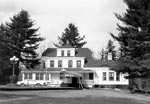 In
1852, a sea captain built what came to be known at the 1852 Inn at Lexington and
Strawberry Roads. The captain had made money trading spices from the Far East
and bought 464 acres. A carriage house in the rear was the first location of the
Mohegan Lake Volunteer Fire Department. The Inn became known as the 1852 Inn in
the 1900s, and later Onofrio's, until it burned to the ground in a tragic fire
in 1993. We wish the Fire Department had remained there! On the site today is a
day care center.
In
1852, a sea captain built what came to be known at the 1852 Inn at Lexington and
Strawberry Roads. The captain had made money trading spices from the Far East
and bought 464 acres. A carriage house in the rear was the first location of the
Mohegan Lake Volunteer Fire Department. The Inn became known as the 1852 Inn in
the 1900s, and later Onofrio's, until it burned to the ground in a tragic fire
in 1993. We wish the Fire Department had remained there! On the site today is a
day care center.
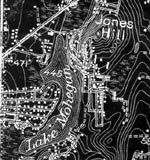 Lake
Mohegan received its name in 1859, given by William Jones, a Welshman who owned
the Mount Pleasant Hotel on the East side of the lake, and some 300 acres in the
vicinity. (Germeck 1967:4,7). Today, the USGS map for the Mohegan Quadrangle
references "Jones Hill" as the large hill on the Northeast side of the
lake (streets: Fenimore, Kimble, Lakeside, Hillside, Heyward). William's son,
Walter Jones, continued to own property in the area, operating Lakelawn Cottages
for years. Lakelawn Cottage, actually a large hotel, was located between Kimble
Avenue and Christine Street on the East side. It was built by his father, who
owned most of the Jones Hill area – what
is now Mohegan Highlands.
Lake
Mohegan received its name in 1859, given by William Jones, a Welshman who owned
the Mount Pleasant Hotel on the East side of the lake, and some 300 acres in the
vicinity. (Germeck 1967:4,7). Today, the USGS map for the Mohegan Quadrangle
references "Jones Hill" as the large hill on the Northeast side of the
lake (streets: Fenimore, Kimble, Lakeside, Hillside, Heyward). William's son,
Walter Jones, continued to own property in the area, operating Lakelawn Cottages
for years. Lakelawn Cottage, actually a large hotel, was located between Kimble
Avenue and Christine Street on the East side. It was built by his father, who
owned most of the Jones Hill area – what
is now Mohegan Highlands.
 Before
1871, the Mohegan Lake School was constructed at what is now St. Mary's church
and the former Monk's Tavern. St. Mary's is itself the last remnant of the
famous Mohegan Lake School, where a military academy for boys turned out some of
the leaders of the day. As early as 1880, and until 1934, Albert Linder drew cadets
from as far as Europe, the Caribbean and states like Vermont, Georgia and Iowa.
Teaching courses from penmanship to Thucididyes, the school produced such
thinkers as Robert Moses, the architect of much of modern New York, and several
Rockefellers. With an enrollment limited to 42, on eight acres of buildings and
parade grounds, the school emphasized "a thorough Christian preparatory
education . . . in an atmosphere free from the distracting and pernicious
influences of large towns and railroad centers."
Before
1871, the Mohegan Lake School was constructed at what is now St. Mary's church
and the former Monk's Tavern. St. Mary's is itself the last remnant of the
famous Mohegan Lake School, where a military academy for boys turned out some of
the leaders of the day. As early as 1880, and until 1934, Albert Linder drew cadets
from as far as Europe, the Caribbean and states like Vermont, Georgia and Iowa.
Teaching courses from penmanship to Thucididyes, the school produced such
thinkers as Robert Moses, the architect of much of modern New York, and several
Rockefellers. With an enrollment limited to 42, on eight acres of buildings and
parade grounds, the school emphasized "a thorough Christian preparatory
education . . . in an atmosphere free from the distracting and pernicious
influences of large towns and railroad centers."  It was set between what is
now Route 6 and Lake Mohegan, and was a spectacular sight indeed. Those speeding
past the church probably never notice the small stone marker and bronze plaque
in front of St. Mary’s. It’s well worth a stop, however. St. Mary's Parish,
formally organized in 1887, and with a history going back 20 years earlier, is
itself an historic site.
It was set between what is
now Route 6 and Lake Mohegan, and was a spectacular sight indeed. Those speeding
past the church probably never notice the small stone marker and bronze plaque
in front of St. Mary’s. It’s well worth a stop, however. St. Mary's Parish,
formally organized in 1887, and with a history going back 20 years earlier, is
itself an historic site.
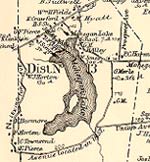 In
the 1872 Beers Atlas of Westchester County, the Hortons and Townsend, both names
of current roads, are in evidence and MacGregor's Pond has become "MacGregory
Pond." Mohegan Lake and MacGregor's Pond in Crompond appear on the 1886 de
Lancey map also. By 1893, the area was well settled. As the Julius Bien Atlas
shows, Mohegan was beginning to be the site of quarrying activity, hotels and
residential development with some familiar names. Among the names and sites
easily recognizable are:
In
the 1872 Beers Atlas of Westchester County, the Hortons and Townsend, both names
of current roads, are in evidence and MacGregor's Pond has become "MacGregory
Pond." Mohegan Lake and MacGregor's Pond in Crompond appear on the 1886 de
Lancey map also. By 1893, the area was well settled. As the Julius Bien Atlas
shows, Mohegan was beginning to be the site of quarrying activity, hotels and
residential development with some familiar names. Among the names and sites
easily recognizable are:
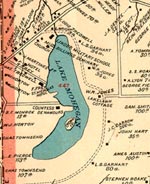 |
- E.
Crawford on East Main St.
- J.
Conklin on East Main St.
- Countess
B.F. de Nemours at the present-day Holland Club property
- Chase
Mohegan Quarry Co. off Lexington Avenue near present-day Route 202
- Wm.
Horton on Route 6
- The
Strangs on Old Yorktown Road (Rte.132)
- The
Field Home
- Lakelawn
Cottage on the East Side of Lake Mohegan, off what is now Mohegan Avenue at
Christine Road (what was later to become Sonoqua Lodge)
- Mrs.
Billings Seminary and Church on Rte 6, where St. Mary's and Ansonia Lodge
are today
|
Undoubtedly,
in the late 1800s, Mohegan residents were either farmers, working on the Mohegan
Farm and others; workers on the Mohegan granite
quarry; in the emery mines off
Croton Avenue and off Furnace Dock Road, in the brick works in Verplank (1,350
employees in 1860); working in the new tourist trade from Route 6; the new
Croton Dam (built in the 1890s), or in Suttons Mills in Annsville.
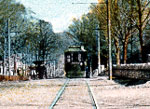 The
Trolley line was built in the 1800s. It carried vacationers from the Peekskill
train station up the Five Mile Turnpike as far as Mill Street on Route 6. Most
travelers undoubtedly got off at Mohegan Lake's main street, some pictures of
which follow. The main buildings are the Horn & Hardhart and Saconey Gas
Station.
The
Trolley line was built in the 1800s. It carried vacationers from the Peekskill
train station up the Five Mile Turnpike as far as Mill Street on Route 6. Most
travelers undoubtedly got off at Mohegan Lake's main street, some pictures of
which follow. The main buildings are the Horn & Hardhart and Saconey Gas
Station.
 The Mohegan
Farm: During the late 1800s, the Mohegan Farm was a local landmark. Located at the
South and East side of the lake – from
Christine Road to Judy Road, to Sylvan Road, the farm covered 300 acres and
produced dairy products, fruit and grains. It was owned and operated by Wm.
Baker, owner of Baker Chocolates, for whom Baker Street is named. We assume the
Mohegan Farm milk cows contributed to the world-famous taste of Baker Chocolate.
Several old stone walls and the old Milk house – converted
into a small home between Judy Road and Turus Lane
–
remains of the once – great
farm.
The Mohegan
Farm: During the late 1800s, the Mohegan Farm was a local landmark. Located at the
South and East side of the lake – from
Christine Road to Judy Road, to Sylvan Road, the farm covered 300 acres and
produced dairy products, fruit and grains. It was owned and operated by Wm.
Baker, owner of Baker Chocolates, for whom Baker Street is named. We assume the
Mohegan Farm milk cows contributed to the world-famous taste of Baker Chocolate.
Several old stone walls and the old Milk house – converted
into a small home between Judy Road and Turus Lane
–
remains of the once – great
farm.
 Kipp's
Bowling Alley was also located on the East side of the lake, adjacent to the
Lakelawn Cottage. This would be between Mohegan Avenue and Lakeshore, near
Christine. This was a popular spot during the late 1800s and early 1900s. A
typical summer evening would probably have included a trip across the lake to
the bowling alley. One reference to the proprietor, Mr. Kipp, is found in the
handwritten court minutes of the local justice of the peace, Enu Brown (himself
a local power broker in those days), who records an incident in which Kipp was
charged with harassment and menacing.
Kipp's
Bowling Alley was also located on the East side of the lake, adjacent to the
Lakelawn Cottage. This would be between Mohegan Avenue and Lakeshore, near
Christine. This was a popular spot during the late 1800s and early 1900s. A
typical summer evening would probably have included a trip across the lake to
the bowling alley. One reference to the proprietor, Mr. Kipp, is found in the
handwritten court minutes of the local justice of the peace, Enu Brown (himself
a local power broker in those days), who records an incident in which Kipp was
charged with harassment and menacing.
Note:
This article is based on David's annual slide show presented at Lake Day in
June; it is a work in progress, and David appreciates contributions of old
photos, stories, and information. Photos can be scanned and returned. David can
be reached at 962-1039.
Continuation in a series of
predictions about the 20th Century from The Ladies Home Journal of December 1900
(click HERE
for the complete list of predictions):
Prediction
#6: “Automobiles
will be cheaper than horses are today. Farmers will own automobile hay-wagons,
automobile truck-wagons, plows, harrows and hay-rakes. A one-pound motor in
one of these vehicles will do the work of a pair of horses or more. Children
will ride in automobile sleighs in winter. Automobiles will have been substituted
for every horse vehicle now known. There will be, as already exist today, automobile
hearses, automobile police patrols, automobile ambulances, automobile street
sweepers. The horse in harness will be as scarce, if, indeed, not even scarcer,
then as the yoked ox is today.”
Prediction
#7: “There
will be air-ships, but they will not successfully compete with surface cars
and water vessels for passenger or freight traffic. They will be maintained
as deadly war-vessels by all military nations. Some will transport men and goods.
Others will be used by scientists making observations at great heights above
the earth.”
Prediction
#8: “Aerial
War-Ships and Forts on Wheels. Giant guns will shoot twenty-five miles or more,
and will hurl anywhere within such a radius shells exploding and destroying
whole cities. Such guns will be armed by aid of compasses when used on land
or sea, and telescopes when directed from great heights. Fleets of air-ships,
hiding themselves with dense, smoky mists, thrown off by themselves as they
move, will float over cities, fortifications, camps or fleets. They will surprise
foes below by hurling upon them deadly thunderbolts. These aerial war-ships
will necessitate bomb-proof forts, protected by great steel plates over their
tops as well as at their sides. Huge forts on wheels will dash across open spaces
at the speed of express trains of to-day. They will make what are now known
as cavalry charges. Great automobile plows will dig deep entrenchments as fast
as soldiers can occupy them. Rifles will use silent cartridges. Submarine boats
submerged for days will be capable of wiping a whole navy off the face of the
deep. Balloons and flying machines will carry telescopes of one-hundred-mile
vision with camera attachments, photographing an enemy within that radius. These
photographs as distinct and large as if taken from across the street, will be
lowered to the commanding officer in charge of troops below.”
The Yorktown Historical Society updates the home page with seasonally appropriate
articles and information. Click here to
read our past issues.
 The
trains now brought people to the Peekskill station and the Yorktown Heights
station (built in 1881). In
1816, "Five Mile Turnpike" was built along what is now Route 6 from
Peekskill to Shrub Oak. Prior to 1816, Red Mill Road was the primary route from
Peekskill to Mohegan. In 1816, an entrepreneur built the turnpike, and a toll
house on East Main Street in Peekskill to save hours off the journey. The
turnpike operated for 50 years until 1869, when the route was purchased as a
public road.
The
trains now brought people to the Peekskill station and the Yorktown Heights
station (built in 1881). In
1816, "Five Mile Turnpike" was built along what is now Route 6 from
Peekskill to Shrub Oak. Prior to 1816, Red Mill Road was the primary route from
Peekskill to Mohegan. In 1816, an entrepreneur built the turnpike, and a toll
house on East Main Street in Peekskill to save hours off the journey. The
turnpike operated for 50 years until 1869, when the route was purchased as a
public road. 







